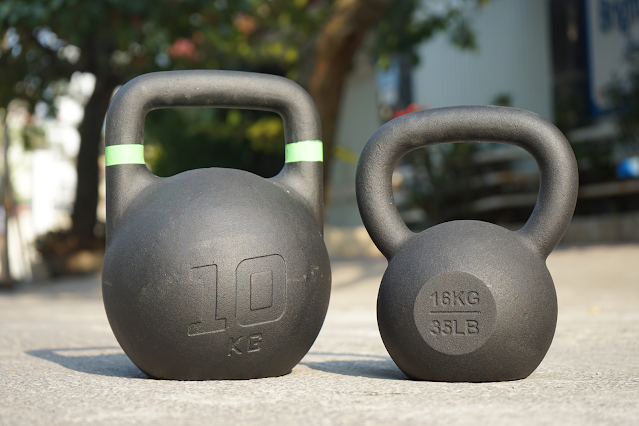What kettlebell size should I choose?
Nowadays, the kettlebell has become prevalent among professional bodybuilders, athletes, and general fitness enthusiasts, and it is considered a staple fitness equipment. We are all acknowledged that during training and weightlifting, safety comes first. Therefore, choosing a suitable size for your kettlebell weight is highly recommended.
Kettlebells are popular because of their flexibility. Through the odd shape structure, kettlebells promote better applications that are lacking in the other bells.
They help burn calories and build muscles by combining multi-joint exercises that target big muscle groups, such as squat, lunge, swing, etc. However, despite the dramatic advantages, people who are starting a new work-out routine usually find it difficult when choosing the appropriate kettlebell size.
VIC is here to help readers recognize the issue and find out which size works for you.
Basically, weight lifting is the activity when you exercise by lifting heavy objects (such as kettlebells, dumbbells, barbells) in order to improve your fitness level, get stronger, and build lean mass. Hence, apart from the form, the lifting weights' size contributes significantly to the training effectiveness.
Although kettlebells are more flexible and compact than barbells, choosing the right size cannot be underrated. In fact, this procedure depends on several aspects.
1. Trainer's experience in weightlifting
 |
| Kettlebell lifting |
a. Your lifting time:
• Beginner: no weightlifting experience.
• Intermediate: from six months to around two years of weightlifting experience.
• Advanced: more than two years of weightlifting experience.
b. Your lifting ability (how heavy can you lift).
c. The amount of muscle and fat you have.
The best 2 types of kettlebells you should buy
2. Trainer’s purpose
Make sure to account for the reason you take up kettlebell training because it can help determine the size, whether you want to lose weight, build strength, enhance endurance, or cardiovascular. After all, self-awareness is the key to performance improvement.
3. Trainer's fitness
 |
| Kettlebell in fitness |
Or, if you are new to weight-training and do not know your ideal weight size nor your ability, there are some tips that you can apply.
• Choose a weight that helps you perform the first ten reps with mild difficulty; by the end of the tenth rep, you should find it challenging to lift but not too hard to strain. If you do, just bring the weight down a little.
• No less than 30 seconds of rest and no more than 60 seconds of rest in sets.
• If you are able to complete the tenth lift of the third set, struggling but without grunting or breaking form, then this is the exact strength you will want to maintain.
• If you find you can do the last lift with little effort, then it is time to increase the weight because progressive overload is a fundamental weight training principle.
Vinyl Vs Powder Coated Kettlebell: which one suits your fitness goal?
4. Trainer's age
Each age group should use different kettlebell sizes.
Though we are all engaged in PE classes at school, serious weightlifting is completely different from that matter.
There's no specific age that's "correct", and it will never be too late to start lifting weight.
However, you should start lifting lightweight when you are at least 16-18 years of age and then lift heavier afterward, avoid "too heavy, too early".
Does kettlebell fit your home gym?
5. Trainer's gender
 |
| Both women and men can practice kettlebell exercises |
We all know that men can lift more absolute weight than women can. Additionally, there are other differences between the genders that appear in metabolism, muscle fiber size, and anabolic hormones.
According to numerous scientific research, although males' bodies recover more quickly, females experience less muscle damage and less inflammation, enhancing their perceived recovery over men.
How can inappropriate size impact your training experience and physical health?
Kettlebells can bring us countless benefits, but unsuitable size, on the other hand, damage our bodies severely. The core of weightlifting is to train the body with a suitable amount of weight using a perfect form; thus, too heavy or too lightweight can definitely deteriorate the work-out.
While too light weights will not cause any significant notice on body appearance and make no progress, going too heavy with weight injures our bodies tremendously. Heavy lifting account for one of the major factors causing injury. Some common are back sprains, wrist injuries, muscle pulls, spinal injuries, etc. In fact, choosing the wrong weight size is one of the common strength training mistakes. How can that happen?
As mentioned above, progressive overload is a fundamental principle of weight training. When you lift slightly heavier, small tears in the muscle fibers and tendons can heal and strengthen your muscles, but too heavyweight makes these tears larger and healing can not be in a short amount of time. Not to mention your spinal will endure a lot more pressure, and the muscle in your back will be strain beyond what they can handle.
That means not only you injure yourself accidentally, but you also fail in training your targeted muscle since these muscle groups can not handle the load of the weights you put on.
Competition Vs Classic Kettlebell: Which one to buy?
Specialized kettlebell size for different users
 |
| Kettlebell size for different users |
|
|
Beginners |
Intermediate |
Advanced |
|
Male |
35lbs (16kg) |
44lbs (20kg) |
53lbs (24kg) |
|
Female |
18lbs (8kg) |
26lbs (12kg) |
35lbs (16kg) |
The recommended kettlebell sizes for kids:
|
Age |
Kettlebell sizes |
|
5-8 years old |
5-8lbs (2-3kg) |
|
9-11 years old |
5-15lbs (2-7kg) |
|
10-20 years old |
10-20lbs (4.5-9kg) |
The recommended kettlebell sizes for seniors (around 60 years of age):
|
Male |
20-26lbs (9-12kg) |
|
Female |
15-18lbs (7-8kg) |




Comments
Post a Comment